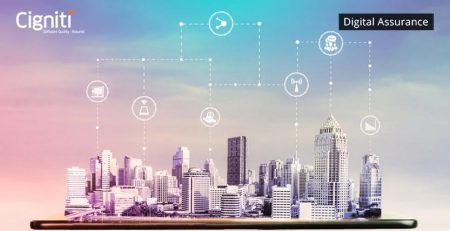5 Key Differences Between Multi-Channel and Omni-Channel Testing
|
Listen on the go!
|
Can an organization build a roadmap for a robust digital business strategy? Most enterprises believe that it is possible and being digital is attainable with the right flow of IT projects and planning. However, spinning the digital wheel is all about building capabilities across various fronts – culture, metrics, people, processes, skills, and technology. It implies preparing your business to get more and more responsive to the needs of the marketplace.
CIOs have a key role to play in this digital landscape, as they need to keep up with the pace of the business and also move faster in the changing circumstances. Technology platforms are evolving each day and in this overall scenario, it becomes imperative for enterprises to give unified experience to its users – external or internal.
Success of an organization totally depends on how well it accepts and manages various challenges posed by Digital transformation. Technology upgrade is often seen as a bottleneck and enterprises are working around the cultural shift by using technology as a boost rather than as a hurdle.
Enterprises are bringing in unified experience across platforms and devices to bring in more acceptance and pace up Digital Transformation. QA and Testing have a massive role to play and ensure that all aspects work cohesively to give the desired experience. Testing cannot be an afterthought, it has be intertwined with the development process.
DevOps and Agile approach has been increasingly adopted by enterprises to enable this process. An organization’s QA and Testing practices are expected to adapt to digital business, accelerating development rather than obstructing the process. QA has to align with the business objectives – focus on customer needs, speak the language of the customer, understand new technology projects, manage test data, and most importantly empower the software development process.
Omni-channel Testing and Multi-channel Testing are absolutely critical in this scenario, where customer experience and needs are expected to bring business growth. Omni-channel Testing is at the core of business-driven initiative across companies and institutions.
An experienced and technically well-equipped team can strategically make this happen. Omni-channel testing comprises a range of aspects, namely, Omni-channel Functional Testing, Omni-channel Compatibility Testing, Omni-channel Usability Testing, Omni-channel Performance Testing, and Omni-channel Security Testing.
While the terms Omni-channel testing and Multi-channel testing sounds interchangeable, there is a difference when it is applied.
Omni-channel testing is executed when the same application has to be tested across platforms/devices for seamless user experience. Multi-channel testing is done when users have to perform common tasks on desktop, mobile, and tablet devices to determine any issues. So, a single user will only test various functionalities of the application on a single device.
For Omni-channel testing, if a Cricket scoring application has to be tested, the users will test the application on various devices for its responsiveness and experience. In the same context for Multi-channel testing, the application will be tested by different users across different devices to review and confirm on the performance of the application’s various features.
Omni-Channel Testing Vs Multi-channel testing, what are the key differences?
- Difference in application
The key difference with both the methodologies is with the process that is tested. If a single application has to be tested that is applicable across multiple devices, Omni-channel testing is considered. On the other hand, if the same feature has to be tested on a range of devices, Multi-channel testing comes into play.
- User & Device approach
In case of Multi-channel testing, users need not repeat the study across devices. Each user has to only do the testing on a single device and test all the features. Specifically, one set of users can test the desktop experience, another set can check tablet experience and so on.
In Omni-channel testing, all the users have to test the application across all devices, log in across devices and share whether the experience has been seamless.
- Enterprise-level approach
In a Multi-channel approach, enterprises focus on exploiting the performance of every channel/device – tablet, desktop, and smartphones take the multichannel strategy. They take a swim-lane approach for each channel and try to maximize from it.
In an Omni-channel approach, the focus is on the customer instead of focusing on the technology platform/device. The approach believes that technology/devices have to empower the customer by giving seamless experience. It believes in giving flexibility to the customer to switch between devices, but still get the same feel. The approach is towards empowerment.
- Customer-engagement strategy
Difference in both the approaches comes down to what strategy an enterprise will adopt to engage with the customers. Multi-channel approach is where companies use multiple platforms to engage and offer the same to the customers.
Omni-channel approach is where companies consider that the customer might initiate an activity on one platform and eventually move on another platform for various possible reasons. Accordingly, the testing happens and the objectives are defined for both.
- Consistency of experience
Omni-channel approach is all about offering a seamless and consistent experience for the customers across channels. The devices can differ, but the experience has to be the same, with same touchpoints across channels. Omnichannel testing is a key approach that is adopted for retail, where brands and retailers are interested in giving seamless and consistent experience to the customers.
Multi-channel testing believes in bringing consistency, but the approach is to create unique experience across channels/devices. So, the objectives for creating consistency will differ.
All in all, adopting a Multi-channel or Omni-channel testing approach will depend to a great extent on the industry/domain. For instance, a retail player will consider Omni-channel testing approach, while a bank will consider a multi-channel approach to test its banking application.
Customer is at the core of Digital Transformation, and preferences of the customer will keep on defining and redefining the QA and testing approach.
Cigniti works with enterprises to devise the right QA approach for their business in the digital era. Cigniti’s Digital assurance & testing solutions address the multi-faceted needs of digital transformation testing.
Connect with us to build responsive QA & testing processes for comprehensive testing across your digital value chain.





Leave a Reply